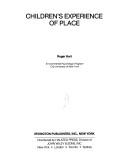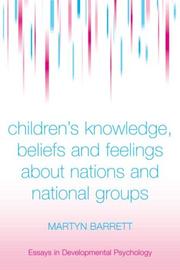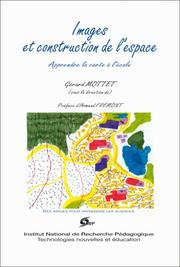| Listing 1 - 8 of 8 |
Sort by
|

ISBN: 0470991909 Year: 1979 Publisher: New York (N.Y.): Irvington publ.
Abstract | Keywords | Export | Availability | Bookmark
 Loading...
Loading...Choose an application
- Reference Manager
- EndNote
- RefWorks (Direct export to RefWorks)

ISBN: 1841693014 Year: 2005 Publisher: Hove, UK : Psychology Press,
Abstract | Keywords | Export | Availability | Bookmark
 Loading...
Loading...Choose an application
- Reference Manager
- EndNote
- RefWorks (Direct export to RefWorks)
Periodical
Abstract | Keywords | Export | Availability | Bookmark
 Loading...
Loading...Choose an application
- Reference Manager
- EndNote
- RefWorks (Direct export to RefWorks)
Geographical perception in children --- Perception géographique chez l'enfant --- Geographical perception in children. --- Barn --- Ungdomar --- sociala förhållanden --- Children --- Perception in children --- Human Geography. --- Children & Childhood. --- Arts and Humanities --- Earth Sciences --- Social Sciences --- Architecture, Fine and Decorative Arts --- Education & Careers --- Society and Culture --- Geography --- General and Others


ISBN: 2734205734 Year: 1997 Volume: 3 Publisher: Paris : Institut national de recherche pédagogique,
Abstract | Keywords | Export | Availability | Bookmark
 Loading...
Loading...Choose an application
- Reference Manager
- EndNote
- RefWorks (Direct export to RefWorks)
Geographical perception in children --- Map drawing --- Cartography --- Cities and towns --- Perception géographique chez l'enfant --- Cartes géographiques --- Cartographie --- Villes --- Study and teaching (Primary) --- Maps --- Study and teaching (Primary) --- Dessin --- Etude et enseignement (Primaire) --- Cartes --- Etude et enseignement (Primaire)
Book
ISBN: 9060017552 Year: 1982 Publisher: Deventer Van Loghum Slaterus
Abstract | Keywords | Export | Availability | Bookmark
 Loading...
Loading...Choose an application
- Reference Manager
- EndNote
- RefWorks (Direct export to RefWorks)
children [people by age group] --- Social policy --- Human sciences --- pedagogiek --- Age group sociology --- sociale ecologie --- #PEDA *S 65 --- Geographical perception in children --- Child psychology. --- Environmental psychology --- Playgrounds --- kinderen --- wonen --- woonomgeving --- 711.5 --- Play centers --- Public playgrounds --- School playgrounds --- Play environments --- Sports facilities --- Community centers --- Parks --- Cognitive ergonomics --- Ecological psychology --- Ecopsychology --- Ecotherapy --- Environmental quality --- Environmental social sciences --- Human factors science --- Psychoeology --- Psychology --- Psychotherapy --- Ecological Systems Theory --- Children --- Perception in children --- Behavior, Child --- Child behavior --- Child study --- Pediatric psychology --- Psychology, Child --- Child development --- Developmental psychology --- Child psychiatry --- Child rearing --- Educational psychology --- bedrijven- en industrieterreinen --- Psychological aspects --- Environmental psychology. --- Geographical perception in children. --- Playgrounds. --- Environmental planning --- public spaces --- Child psychology
Book
ISBN: 9789038213224 Year: 2008 Volume: *1 Publisher: Gent Academia Press
Abstract | Keywords | Export | Availability | Bookmark
 Loading...
Loading...Choose an application
- Reference Manager
- EndNote
- RefWorks (Direct export to RefWorks)
Deze studie gaat in op de vraag welke betekenis de woonomgeving heeft in het socialisatieverloop van kinderen. De woonomgeving wordt benaderd als een feitelijk socialisatiekader dat mee vorm geeft aan het burgerschap van kinderen en als de ruimtelijke weergave van sociale praktijken, relaties en machtsverhoudingen in de samenleving. De woonomgeving wordt geanalyseerd aan de hand van een case study in drie contrasterende stedelijke woonomgevingen: Nieuw Gent, Steenakker en Sint-Pieters-Buiten (Gent). Hiervoor worden van elke woonomgeving een sociaal-ruimtelijke kaart (op basis van historisch bronnenonderzoek), een mentale kaart (op basis van mondelinge geschiedenissen met volwassenen die als kind zijn opgegroeid in het onderzoeksgebied) en personal map (op basis van door kinderen genomen foto's over hun feitelijke aanwezigheid in de woonomgeving) opgesteld. De verschillende patronen in de feitelijke aanwezigheid van kinderen in de woonomgeving worden bepaald door de specifieke interacties Tussen de gebouwde, de gedeelde en de geleefde woonomgeving. Een gemeenschappelijke lijn die in elke case zit, is dat in de contructie van de woonomgeving bepaalde opvattingen over de publieke sfeer zijn verwerkt, dat bewoners zich deze contructie op een bepaalde manier hebben eigen gemaakt, en dat kinderen zich op een eigen manier verhouden tegenover deze contructie en zich hun woonomgeving op uiteenlopende manieren toe-eigenen Inhoudsopgave : DEEL 1 DE WOONOMGEVING ALS SOCIAAL-PEDAGOGISCHE THEMATIEK Hoofdstuk 1 - Probleemstelling Hoofdstuk 2 - De 'goede' woonomgeving van kinderen Hoofdstuk 3 - De goede woonomgeving: welke opvoeding ten aanzien van welk kind? Hoofdstuk 4 - Van wenselijkheid naar werkelijkheid: burgerschap als invalshoek DEEL 2 DE SOCIAAL-PEDAGOGISCHE BETEKENIS VAN DE WOONOMGEVING - EMPIRISCH ONDERZOEK Hoofdstuk 5 - Methodologische inleiding Hoofdstuk 6 - De gebouwde woonomgeving Hoofdstuk 7 - De gedeelde woonomgeving Hoofdstuk 8 - De geleefde woonomgeving Hoofdstuk 9 - Besluit.
Kinderen en wonen. --- Pedagogie. --- Sociale agogiek --- Jeugdwerk- en beleid. --- Age group sociology --- woonplaats --- Educational sciences --- sociale pedagogiek --- woonomgeving --- ruimtelijke oriëntatie --- kinderen --- Sociology of environment --- socialisatie --- wonen --- Playgrounds --- Design and construction --- Child psychology --- Geographical perception in children --- 303.82 --- casestudies --- leefwereld --- Wonen --- Samenleving --- Woonomgeving --- Interactie --- Kinderen --- Socialisatie --- Jeugd --- Kind --- Socialisatie (sociale wetenschap) --- Media --- Ontwikkelingsstoornis --- Fysiotherapie --- stedelijk leefmilieu --- Jongere
Book
ISBN: 074500931X 0745009301 0389209872 Year: 1992 Publisher: Hemel Hempstead Harvester Wheatsheaf
Abstract | Keywords | Export | Availability | Bookmark
 Loading...
Loading...Choose an application
- Reference Manager
- EndNote
- RefWorks (Direct export to RefWorks)
Geografie --- Geographical perception in children. --- Environment --- ORIENTATION --- SPACE PERCEPTION, in infancy and childhood --- Sociale geografie --- Maatschappij. --- in infancy and childhood --- Environment. --- SPACE PERCEPTION, in infancy and childhood. --- in infancy and childhood. --- Orientation --- Space perception, in infancy and childhood. --- In infancy and childhood.
Book
ISBN: 981287044X 9812870431 9812870458 Year: 2016 Publisher: Singapore : Springer Nature Singapore : Imprint: Springer,
Abstract | Keywords | Export | Availability | Bookmark
 Loading...
Loading...Choose an application
- Reference Manager
- EndNote
- RefWorks (Direct export to RefWorks)
This volume demonstrates the multiple ways that space, place and environment interact with children and young people’s lives. The contributors offer a suite of cutting-edge tools and lively examples for theorising how space, place and environment are (con)figured in children and young people’s lives. They demonstrate how the social borders between childhood and adulthood, and spatial borders between rural and urban, countries, neighbourhoods, and institutions, are relationally produced. The volume is organised into five sections: Indigenous Youth: Space and Place; Children, Nature and Environmental Education; Urban Spaces; Home/less Spaces; and Border Spaces. These themes signal the major issues in cutting-edge children’s geographies scholarship. Diverse geographical contexts are covered in this volume – including Australia, Brazil, Canada, Cyprus, Ecuador, India, Indonesia, Kazakhstan, Mexico, Morocco, New Zealand, Peru, Slovenia, Spain, the United Kingdom and the United States. All of the contributors advocate greater recognition of children and young people’s spatial rights, whether in the home, outdoors, at school, crossing borders, in public and digital spaces, or simply looking for a safe place to sleep. Children and young people’s perspectives on space, place and the environment, and their desire for places to call their own, tie the volume together. The volume is a testament to the politics of the spaces and places of childhood, highlighting how many children and young people face obstacles to living well and to living where they desire. .
Social sciences. --- Sociology. --- Childhood. --- Adolescence. --- Social groups. --- Human geography. --- Social Sciences. --- Human Geography. --- Childhood, Adolescence and Society. --- Sociological Theory. --- Anthropo-geography --- Anthropogeography --- Geographical distribution of humans --- Social geography --- Association --- Group dynamics --- Groups, Social --- Teen-age --- Teenagers --- Childhood --- Kids (Children) --- Pedology (Child study) --- Youngsters --- Social theory --- Behavioral sciences --- Human sciences --- Sciences, Social --- Social science --- Social studies --- Development --- Anthropology --- Geography --- Human ecology --- Geographical perception in children. --- Children --- Perception in children --- Social sciences --- Puberty --- Age groups --- Families --- Life cycle, Human --- Sociology of Family, Youth and Aging. --- Associations, institutions, etc. --- Social participation
| Listing 1 - 8 of 8 |
Sort by
|

 Search
Search Feedback
Feedback About
About Help
Help News
News